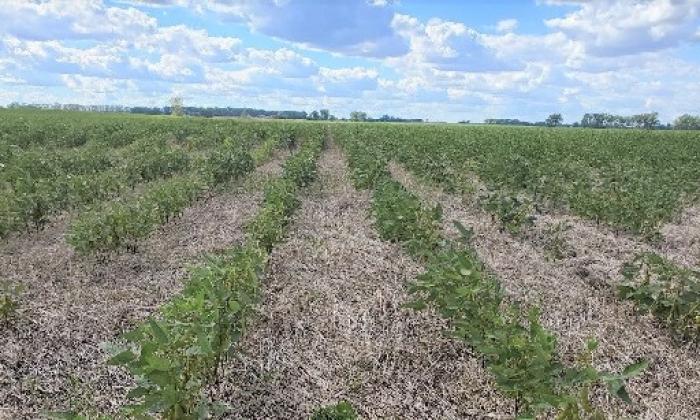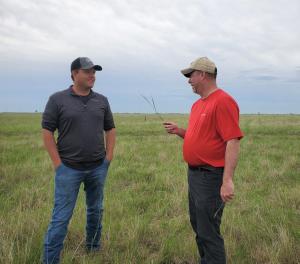Grand Forks County Prairie Project Gives Producers Opportunity to Try Conservation Practices
Dale Benson is trying no-till and cover crops in a region of North Dakota where many farmers have been quick to say, “those practices don’t work here.”
He farms in the northern Red River Valley, west of Grand Forks. The growing season is short. Soils sometimes warm up slowly in the spring and frosts can come early in the fall. Farmers have traditionally tilled fields to dry them out and warm up the soils. Unfortunately, the Grand Forks prairie’s fine textured soils are prone to wind erosion. Also, saline areas have expanded significantly during the past several decades. Salt levels are so high in some places that very little grows in the soil.
Benson, of Arvilla, is tackling some of those problems by participating in the Grand Forks County Prairie Project (GFCPP). It is a collaboration between the US

DA Natural Resources Conservation Service North Dakota, University of North Dakota, North Dakota Natural Resources Trust, Grand Forks County Prairie Partners, U.S. Fish and Wildlife Service, North Dakota Game and Fish Department and Audubon Dakota. The goal is to increase the use of conservation practices on nearly 11,000 acres of cropland and grassland in the county.
A $375,000 NRCS Regional Conservation Partnership Program grant is funding the latest round of financial and technical assistance for eligible practices, including:
- No-till and reduced-till residue management.
- Cover crops.
- Forage planting.
- Livestock water development.
- Cross fencing.
- Rotational grazing.
The practices promise to protect soil from erosion, boost soil health, preserve grasslands and can help make the farmers and ranchers more profitable, sustainable and resilient -- especially in the face of challenging climate conditions, says Lorilie Atkinson, NRCS soil conservationist, Grand Forks field office.
No yield loss
Benson is pleased with the no-till trials that he has done with the GFCPP so far.
“I haven’t lost any yield yet,” he says. He has compared two seasons of no-till soybeans seeded into wheat stubble to his usual practice of doing some type of reduced tillage before planting soybeans.
No yield reduction is a win for no-till in Benson’s book. “I’m not necessarily looking to increase yields,” he says. “I am trying to save the soil. Once it erodes, it is gone.”
Greg Amundson, Gilby, is trying no-till and cover crops, too. He converted land coming out of the Conservation Reserve Program by no-tilling it rather than working up the grass and then planting it.
“It turned out well,” he says. If he had tilled the CRP ground, the soil would have been exposed to wind erosion throughout the fall, winter and early spring.
Amundson usually seeds cover crops after small grains. Live roots in the soil in the fall and early spring help increase soil microorganism populations while protecting the soil from the wind.

Most years, raising corn and soybeans in the Grand Forks prairie poses a different challenge. There isn’t enough time after harvesting corn or soybeans to get a cover crop seeded and established before a hard freeze. He’d like to try interseeding, which is the practice of planting a cover crop mix between corn and soybean rows early in the growing season. Often, enough light reaches the ground between the rows before corn and soybeans canopy to get cover crops started. Once the corn and soybean plants start maturing and begin drying, sunlight can penetrate the canopy allowing the cover crops to grow more vigorously. After harvest, the cover crops protect the soil from the wind and provide food for the soil organisms.
Support from the GFCPP reduces the risk of trying new conservation practices. “It can be a big help,” Amundson says.
Grassland projects
Ben Draxton, Thompson, is also in the project. He has a commercial cow-calf/stocker operation.
He laid more than 17,000 feet of new water lines and installed six new watering tanks to improve grazing distribution across 700 acres of grasslands. He built 30,000 feet of perimeter and cross fence and turned four pastures into 15-20 paddocks. The water and fence makes it possible to rotationally graze the cattle. Rotational grazing utilizes the grasses more efficiently than the once-over system he used to use. He also is able to graze the paddocks at different times of the year, which will allow him to suppress some grass species and encourage the growth of others.
The nutritional quality of grasses has already risen, Draxton reports. The more rapid graze/rest cycle keeps grasses in the vegetative growth stages longer in the fall. He hopes native grasses will eventually move back in.

Ben Draxton (left) talks to Mark Hayek, NRCS North Dakota state rangeland management specialist about his rotation grazing program.
“I am seeing more little bluestem and I’m getting some suppression of foxtail barley,” he says.
Having clean, fresh water available for the cattle seems to have had a positive effect on their health and rates of gain, too.
“I’d like to make the cattle operation more profitable and sustainable,” says Draxton, who is operating land that his grandfather bought in the 1970s. “Some of this land isn’t suited for cropland. It should stay in grass.”
Hard data
Students and staff from the University of North Dakota biology department are helping document changes conservation practices brings to the land. They are counting plant and insect populations, monitoring soil properties and tracking soil biology on land enrolled in conservation projects and comparing it to data collected from adjacent land managed conventionally.
“We hope that what farmers and ranchers report changing on their land -- and what the data gathered by UND shows -- will give more producers and landowners the confidence to try some of these conservation practices,” Atkinson says.
For high resolution images, click here.
Media contact:
Lon Tonneson
for the Natural Resources Conservation Service - North Dakota
lon.tonneson@gmail.com
701-361-1105

